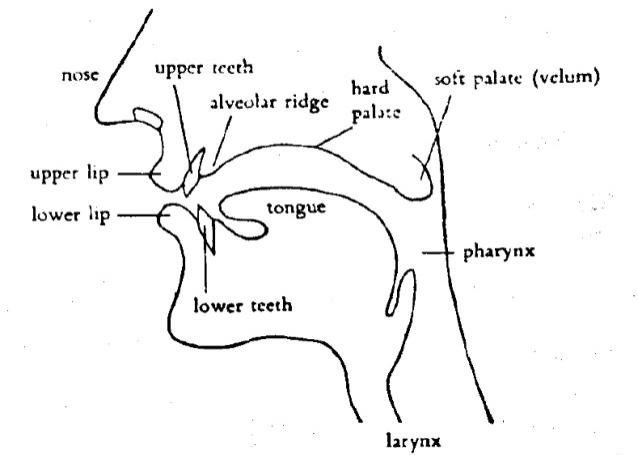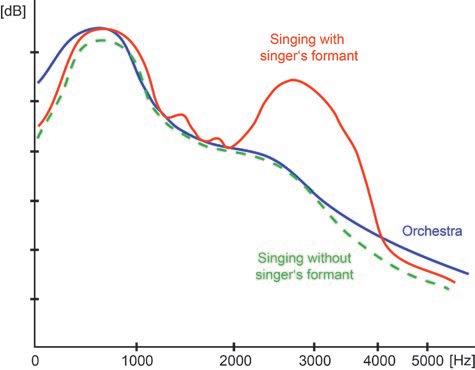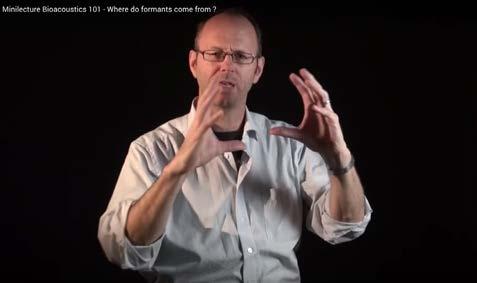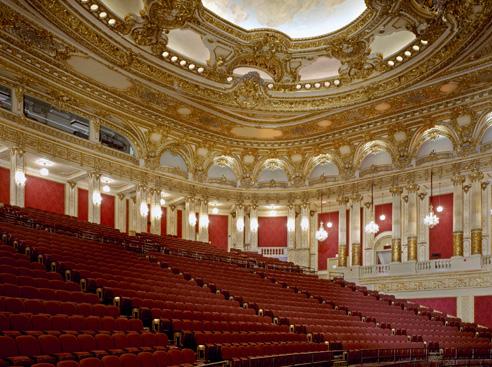
9 minute read
The Science and Art of Opera
THE SCIENCE AND ART OF OPERA

Advertisement
So Young Park as Queen of the Night Photo: Eric Antoniou
WHY DO OPERA SINGERS SOUND LIKE THAT?
Opera is unique among forms of singing in that singers are trained to be able to sing without amplification, in large theaters, over an entire orchestra, and still be heard and understood! This is what sets the art form of opera apart from similar forms such as musical theater. To become a professional opera singer, it takes years of intense physical training and constant practice— not unlike that of a ballet dancer—to stay in shape. Additionally, while ballet dancers can dance through pain and illness, poor health, especially respiratory issues and even allergies, can be severely debilitating for a professional opera singer. Let’s peek into some of the science of this art form.
Singing requires different parts of the body to work together: the lungs, the vocal cords, the vocal tract, and the articulators (lips, teeth, and tongue). The lungs create a flow of air over the vocal cords, which vibrate. That vibration is amplified by the vocal tract and broken up into words by consonants produced by the articulators.
BREATH
VIBRATION
Any good singer will tell you that good breath support is essential to produce quality sound. Breath is like the gas that goes into your car. Without it, nothing runs. In order to sing long phrases of music with clarity and volume, opera singers access their full lung capacity by keeping their torso elongated and releasing the lower abdomen and diaphragm muscles, which allows air to enter into the lower lobes of the lungs. This is why we associate a certain posture with opera singers. In the past, many operas were staged with singers standing in one place to deliver an entire aria or scene, with minimal activity. Modern productions, however, often demand a much greater range of movement and agility onstage, requiring performers to be physically fit, and disproving the stereotype of the “fat lady sings.”
If you run your fingers along your throat you will feel a little lump just underneath your chin. That is your “Adam’s Apple,” and right behind it, housed in the larynx (voice-box), are your vocal cords. When air from the lungs crosses over the vocal cords, it creates an area of low pressure (Google The Bernoulli Effect), which brings the cords together and makes them vibrate. This vibration produces a buzz. The vocal cords can be lengthened or shortened by muscles in the larynx, or by increasing the speed of airflow. This change in the length and thickness of the vocal cords is what allows singers to create different pitches. Higher pitches require long, thin cords, while low pitches require short, thick ones. Professional singers take great pains to protect the delicate anatomy of their vocal cords with hydration and rest, as the tiniest scarring or inflammation can have noticeable effects on the quality of sound produced.
RESONANCE
ARTICULATION
Without the resonating chambers in the head, the buzzing of the vocal cords would sound very unpleasant. The vocal tract, a term encompassing the mouth cavity, and the back of the throat, down to the larynx, shapes the buzzing of the vocal cords like a sculptor shapes clay. Shape your mouth in an ee vowel (as in eat), and then sharply inhale a few times. The cool sensation you feel at the top and back of your mouth is your soft palate. The soft palate can raise or lower to change the shape of the vocal tract. Opera singers always strive to sing with a raised soft palate, which allows for the greatest amplification of the sound produced by the vocal cords. Different vowel sounds are produced by raising or lowering the tongue. Say the vowels: ee, eh, ah, oh, oo and notice how each vowel requires a slightly lower tongue placement. This area of vocal training is particularly difficult because none of the anatomy is visible from the outside!
The lips, teeth, and tongue are all used to create consonant sounds, which separate words into syllables and make language intelligible. Consonants must be clear and audible for the singer to be understood. Because opera singers do not sing with amplification, their articulation must be particularly good. The challenge lies in producing crisp, rapid consonants without interrupting the connection of the vowels (through the controlled exhale of breath) within the musical phrase.

Perfecting every element of this complex singing system requires years of training, and is essential for the demands of the art form. An opera singer must be capable of singing for hours at a time, over the top of an orchestra, in large opera houses, while acting and delivering an artistic interpretation of the music. It is complete and total engagement of mental, physical, and emotional control and expression. Therefore, think of opera singers as the Olympic athletes of the stage, sit back, and marvel at what the human body is capable of!
Different Voice Types Opera singers are cast into roles based on their tessitura (the range of notes they can sing comfortably). There are many descriptors that accompany the basic voice types, but here are some of the most common ones:
Soprano
MezzoSoprano
Contralto
Tenor
Baritone
Bass
Bass The lowest male voice, basses often fall into two main categories: basso buffo, which is a comic character who often sings in lower laughing-like tones, and basso profundo, which is as low as the human voice can sing! Doctor Bartolo is an example of a bass role in The Barber of Seville by Rossini.
Baritone A middle-range male voice, baritones can range from sweet and mild in tone, to darker dramatic and full tones. A famous baritone role is Rigoletto in Verdi’s Rigoletto. Baritones who are most comfortable in a slightly lower range are known as Bass-Baritones, a hybrid of the two lowest voice types.
Tenor The highest male voice, tenors often sing the role of the hero. One of the most famous tenor roles is Roméo in Gounod’s Roméo et Juliet. Occasionally men have cultivated very high voices singing in a range similar to a mezzo-soprano, but using their falsetto. Called the Countertenor, this voice type is often found in Baroque music. Countertenors replaced castrati in the heroic lead roles of Baroque opera after the practice of castration was deemed unethical.
Each of the voice types (soprano, mezzo-soprano, tenor, baritone, bass) also tends to be sub-characterized by whether it is more Lyric or Dramatic in tone. Lyric singers tend toward smooth lines in their music, sensitively expressed interpretation, and flexible agility. Dramatic singers have qualities that are attributed to darker, fuller, richer note qualities expressed powerfully and robustly with strong emotion. While it’s easiest to understand operatic voice types through these designations and descriptions, one of the most exciting things about listening to a singer perform is that each individual’s voice is unique, therefore each singer will interpret a role in an opera in a slightly different way.
Contralto Occasionally women have an even lower range that overlaps with the highest male voice. This voice type is more rare and they often play male characters, referred to in opera as trouser roles.
Mezzo-Soprano Somewhat equivalent to the lower female alto role in a chorus, mezzo-sopranos (mezzo translated as “middle”) are known for their full and expressive qualities. While they don’t sing frequencies quite as high as sopranos, their ranges do overlap, and it is a “darker” tone that sets them apart. One of the most famous mezzo-soprano lead roles is Carmen in Bizet’s Carmen.
Soprano The highest female voice. Some sopranos are designated as coloratura as they specialize in being able to sing very fast moving notes that are very high in frequency and light in tone, often referred to as “color notes.” One of the most famous coloratura roles is The Queen of the Night in Mozart’s The Magic Flute.
What is it about opera singers that allows them to be heard above the orchestra? It’s not that they are simply singing louder. The qualities of sound have to do with the relationship between the frequency (pitch) of a sound, represented in a unit of measurement called hertz, and its amplitude, measured in decibels, which the ear perceives as loudness. Only artificially produced sounds, however, create a pure frequency and amplitude (these are the only kinds that can break glass). The sound produced by a violin, a drum, a voice, or even smacking your hand on a table, produces a fundamental frequency as well as secondary, tertiary, etc. frequencies known as overtones, or as musicians call them, harmonics.
For instance, the orchestra tunes to a concert “A” pitch before a performance. Concert “A” has a frequency of about 440 hertz, but that is not the only pitch you will hear. Progressively softer pitches above that fundamental pitch are produced in multiples of 440 at 880hz, 1320hz, 1760hz, etc. Each different instrument in the orchestra, because of its shape, construction, and mode in which it produces sound, produces different harmonics. This is what makes a violin, for example, have a different color (or timbre) from a trumpet. Generally, the harmonics of the instruments in the orchestra fade around 2500hz. Overtones produced by a human voice—whether speaking, yelling, or singing—are referred to as formants.
As the demands of opera stars increased, vocal teachers discovered that by manipulating the empty space within the vocal tract, they could emphasize higher frequencies within the overtone series—frequencies above 2500hz. This technique allowed singers to perform without hurting their vocal chords, as they are not actually singing at a higher fundamental decibel level than the orchestra. Swedish voice scientist, Johann Sundberg, observed this phenomenon when he recorded the worldfamous tenor Jussi Bjoerling in 1970. His research showed multiple peaks in decibel level, with the strongest frequency (overtone) falling between 2500 and 3000 hertz. This frequency, known as the singer’s formant, is the “sweet spot” for singers so that we hear their voices soaring over the orchestra into the opera house night after night.


Prof. Tecumseh Fitch, evolutionary biologist and cognitive scientist at the University of Vienna, explains the difference between a fundamental frequency and formant frequency in the human voice. For an opera singer, the lower two formants (peaks on a graph) determine the specific vowel sound. The third formant and above add overtones that are specific to each particular singers’ voice, like a fingerprint. When two people sing the same note simultaneously, the high overtones allow your ear to distinguish two voices
The final piece of the puzzle in creating the perfect operatic sound is the opera house or theater itself. Designing the perfect acoustical space can be an almost impossible task, one which requires tremendous knowledge of science, engineering, and architecture, as well as an artistic sensibility. The goal of the acoustician is to make sure that everyone in the audience can clearly understand the music being produced onstage, no matter where they are sitting. A perfectly designed opera house or concert hall (for non-amplified sound) functions almost like gigantic musical instrument.
Boston Opera House – photo by John Wolf


Boston Symphony Hall, opened in 1900, with acoustical design by Harvard physicist Wallace Clement Sabine, was the first concert hall to be designed with scientific acoustic principles in mind. Each seat was mathematically designed and placed for maximum acoustical perfection.
Reverberation is one key aspect in making a singer’s words intelligible or an orchestra’s melody clear. Imagine the sound your voice would make in the shower or a cave. The echo you hear is reverberation caused by the large, hard, smooth surfaces. Too much reverberation (bouncing sound waves) can make words difficult to understand. Resonant vowel sounds overlap as they bounce off of hard surfaces and cover up quieter consonant sounds. In these environments, sound carries a long way but becomes unclear or, as it is sometimes called, wet as if the sound were underwater. Acousticians can mitigate these effects by covering smooth surfaces with textured materials like fabric, perforated metal, or diffusers, which absorb and disperse sound. These tools, however, must be used carefully, as too much absorption can make a space dry – meaning the sound onstage will not carry at all and the performers may have trouble even hearing themselves as they perform. Imagine singing into a pillow or under a blanket.
The shape of the room itself also contributes to the way the audience perceives the music. Most large performance spaces are shaped like a bell – small where the stage is, and growing larger and more spread out in every dimension as one moves farther away. This shape helps to create a clear path for the sound to every seat. In designing concert halls or opera houses, big decisions must be made about the construction of the building based on acoustical needs. Even with the best planning, the perfect acoustic is not guaranteed, but professionals are constantly learning and adapting new scientific knowledge to enhance the audience’s experience.



